On the night of 30th / 31st January 1943 the crew of this 9 Squadron Lancaster were due to fly an operational flight to bomb Hamburg. In total 148 aircraft were despatched to the target and this specific aircraft took off at 23.50hrs from Waddington. It may be of interest that this raid was the first to use H2S radar on the Pathfinder aircraft, however on this date the H2S was not effective. This flight was the second operational flight that this crew had flown together since arriving at 9 Squadron. The crew bombed the target area without incident and made for home but poor weather over Lincolnshire saw them receive a diversion signal at around 06.15hrs telling them to head toward Leeming airfield in Yorkshire to land there. The wireless operator transmitted an acknowledgement of the diversion. The weather further north over North Yorkshire was terrible and this gave the crew little scope for landing easily. There was 10/10ths cloud cover at Leeming at 1000 feet above the ground and it was also raining. The crew became lost and made repeated wireless transmissions which were picked up by both Leeming and Topcliffe airfields but the crew were unable to locate either airfield. By 07.20hrs the aircraft's fuel situation became a major problem and the crew had feathered three of the engines so only the starboard outer engine was running. A Lancaster could fly on one engine but would gradually lose height so the crew would have realised that the aircraft was by now too low for anyone to attempt to bale out. Just before 07.30hrs the crew lowered the undercarriage and in impossible conditions attempted a landing on the North Yorkshire Moors in thick cloud presumably being totally unable to see the ground on which the aircraft was descending toward. They were flying roughly north to south and toward the main escarpment which forms the southern side of the North Yorkshire Moors and known locally as Tabular Hills. This escarpment begins at Black Hambleton (in the west) and heading east includes the Hawnby and Easterside hills, Newgate Bank, Cowhouse Bank, to name only a few and continues all the way to the coast. Had they not attempted a landing they would have flown directly at it and not really knowing it was there would have only resulted in a crash, just as a Whitley had done further west earlier in the war. The Lancaster attempted a landing close to Hawnby Hill but this resulted in a crash. All seven airmen were killed. The lack of fuel may have been down to the fuel system being damaged by enemy action earlier in the night.
I learn from speaking to local people they believed that the crew must have known they were flying at too low a height and prior to the crash were throwing anything out of the aircraft to try and gain that extra bit of height. Backing this story up of things being thrown from the aircraft is that a Browning machine gun was located by Brian Rapier in the 1970s and is shown photographed in his "White Rose Base" book. It was in a poor condition and a gun which appears to be the same one was last seen on display in the Air Gunner Room at the Yorkshire Air Museum in 2005. Propellor marks are said to be visible on the moor near Moorgate but I have yet to locate them. There was also a thin plantation of trees that extended from Moorgate due west at the time and the aircraft had almost certainly travelled through this. Both main wheels had broken off in the initial impact and were found some distance from the eventually finishing point.
Lancaster ED481 was built to contract B69274/40 by A.V. Roe Ltd in Manchester and was delivered directly to 9 Squadron at Waddington on 15th January 1943. It was still a new aircraft and only two weeks old when it was written off in the incident detailed above on 31st January 1943. The AM Form 78 stated damage was only at Cat.B/FB. This must be an error but if it is not a mistake then the severely damaged aircraft must have been recovered and later re-assessed as Re-Cat.E soon after. It was struck off charge on 10th February 1943 having clocked up just nineteen flying hours from new.
Pilot - WO2 Frank Goheen Nelson RCAF (R79092), aged 24, Atlantic City, New Jersey, USA. Buried Dishforth Cemetery, Yorkshire.
Flight Engineer - Sgt McKeen Allen RCAF (R/64851), aged 33, of Northport, Nova Scotia, Canada. Buried Dishforth Cemetery, Yorkshire.
Navigator - Sgt George Francis Done RAFVR (1338385), aged 21, of Carmarthen. Buried Northwich Cemetery, Cheshire.
Navigator/Bomber - Sgt Alan Arthur Frederick Williams RAFVR (1391272), aged 26, of Whitstable. Buried Seasalter Churchyard, Kent.
Wireless Operator / Air Gunner - Sgt Henry Summers Jones RAFVR (1192740), aged 21, of Sutton Coldfield, Warwickshire. Buried Sutton Coldfield, Warwickshire.
Air Gunner - Sgt Arthur William Butcher RAFVR (1578256), aged 19, of Upper Tysoe, Warwickshire. Buried Tysoe Cemetery, Warwickshire.
Air Gunner - Sgt Walter George Murton RAFVR (778803), aged 21, of Capetown, South Africa. Buried Dishforth Cemetery, Yorkshire.

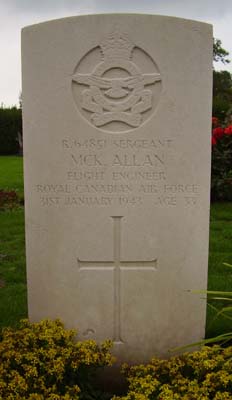
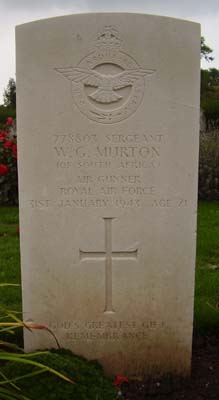

Four of the crew's headstones. I have been unable to locate any photographs of this crew but welcome contact from anyone who can supply any.
Frank Nelson was born on 15th April 1918 in Atlantic City, New Jersey, USA and was the son of Frank Goheen (Snr) and Frances Cleveland (nee Wilks) Nelson. His father died when he was young. After leaving high school in Atlantic City he was employed in various clerical jobs until March 1939 when he attended an aircraft mechanic's ground school course with assistance from the National Youth Administration training programme. With this training it resulted in him gaining employment at the Glenn L.Martin Company, of Baltimore, Maryland, USA to work in the assembly of Martin aircraft. He was allowed to leave this job to enlist for RCAF service in early 1941. This was well before the USA entered the Second World War. When he enlisted into the RCAF on 5th February 1941 in Montreal he stated that he wished to serve as aircrew and to train as a pilot. After basic training in Canada he was awarded his Wings on 21st November 1941. On arrival in the UK in January 1942 over the coming months he was posted to 6 (P)AFU. On 5th May 1942 he was involved in a flying accident while undertaking a day time training flight at 6 (P)AFU. He was flying in Oxford R6338 with an instructor and practicing precautionary landings, when the aircraft was approaching Windrush landing ground where a landing was to be made the aircraft was too low and was going to undershoot the landing site. The accident report stated that his instructor gave the instruction "bags of throttle" which Frank mis-understood to have been "back with throttle" and as a result of reducing power the aircraft sank to the ground and crashed. Both he and the instructor escaped injury but the aircraft received minor damage. The instructor was blamed for the incident and it was stated that it would have been wiser to have used "more conventional language when giving orders". He was later continued his training at 25 OTU at Finningley before completing his training at 1654 Conversion Flight. He was posted to 9 Squadron on 23rd December 1942. By the time the CWGC compiled their records after the war his mother was living in Wilkinsburg, Pennsylvania, USA.
McKeen Allen was born on 7th October 1910 in Northport, Nova Scotia, Canada and was the son of George Chandler and Florence (nee Hunter) Allen. On 5th August 1940 he was working as a fisherman and mechanic when he enlisted for RCAF service for ground duties and had initially trained and served as an aero engine mechanic. On arrival in the UK in January 1942 he was posted to 420 Squadron as an aero engine mechanic as a member of ground crew. With the need for aircrew flight engineers to serve in the larger bombers a number of skilled members of ground crew opted to re-muster and train as flight engineers, he was one of these young men and re-mustered in September 1942. He qualified as a flight engineer at No.4 School of Technical Training on 16th October 1942. He was then posted to 1654 Conversion Unit on 19th October 1942 and then on to 9 Squadron on 22nd December 1942. All throughout his service file his surname is spelt Allen, CWGC however have spelt his name as Allan and the text on his gravestone is given as that.
George Done was born on 2nd May 1921 at Northwich, Cheshire and had gained a teachers diploma at Trinity College, Carmarthen before enlisting into the RAFVR on 28th May 1941.
Alan Williams was born on 12th February 1916 at Dover, Kent and had previously a member of the Metropolitan Police Force before enlisting into the RAFVR on 28th May 1941.
Henry Jones was born on 6th February 1921 at Rhyl, Flintshire and enlisted for RAF service on 16th September 1940.
Arthur Butcher was born on 10th August 1923 at Banbury and enlisted for RAF service on 1st September 1941.
Walter Murton was born on 6th June 1921 at Capetown, South Africa and enlisted for RAF service on 11th November 1941.
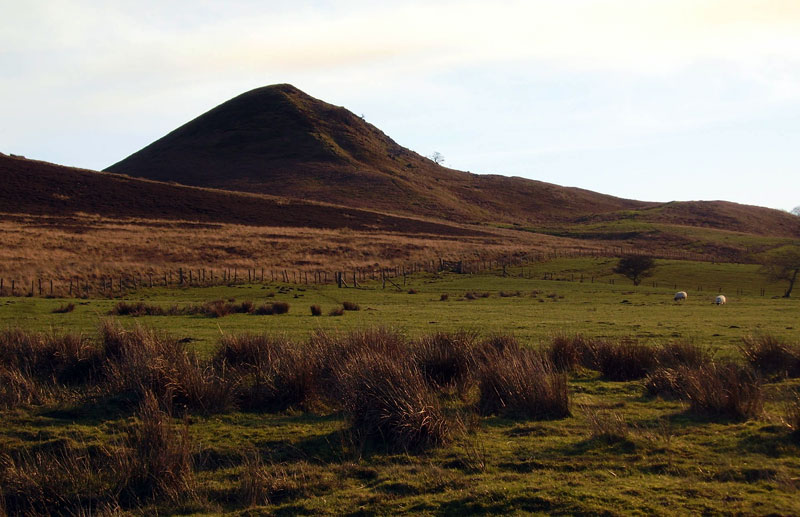
The aircraft crashed into the foreground of the above photograph, on various visits to the site I located a depression on the moor which had an amount of wreckage in it. In 2012 all this wreckage had gone.
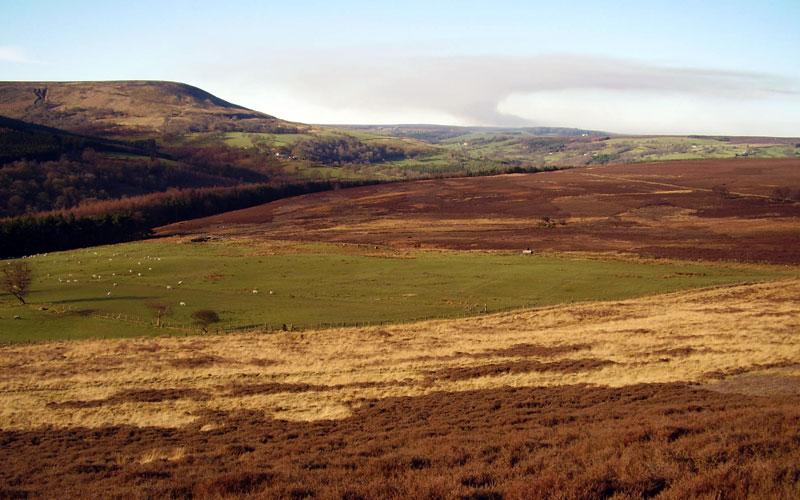
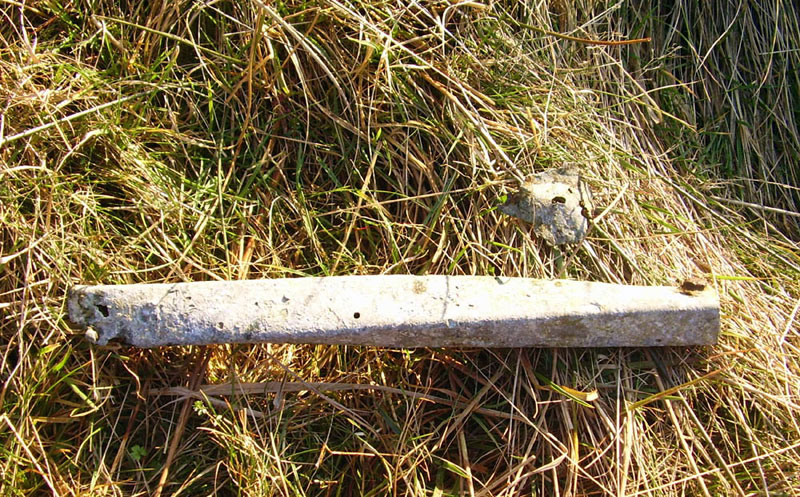
Two small pieces of the aircraft still left at the crash site in 2012.
My thanks to Mr J Weighell who visited this crash hours after it happened, he believed that the aircraft had flown straight into the side of the hill and did not strike trees or anything prior to the crash.